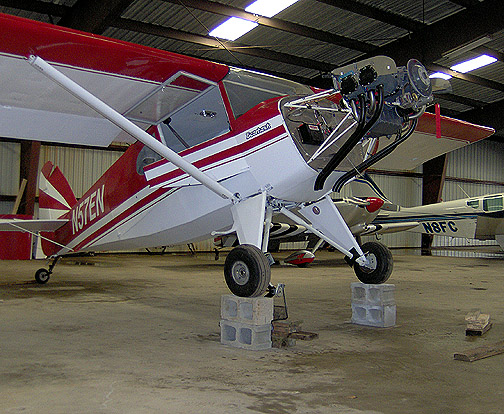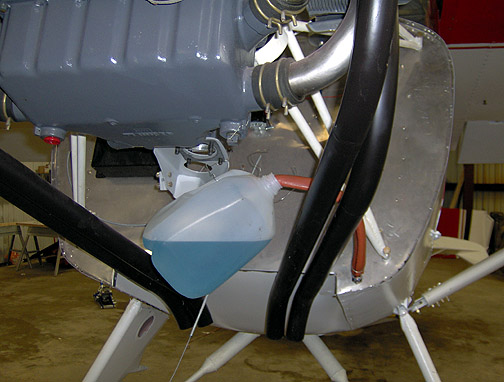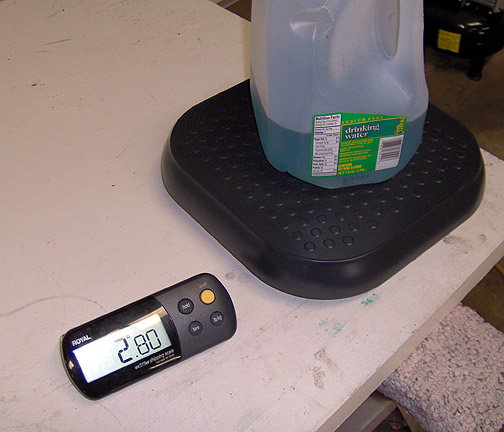Fuel Flow Testing
March 15, 2008
As previously covered, the fuel system in my Bearhawk is a gravity fed system
with no fuel pumps. The system follows the plans (see January 1999
Bear-Tracks newsletter) exactly with the exception that it has a fuel flow
sensor inline between the gascolator and the firewall..
The fuel flow testing was done in accordance with the 14 CFR 23.955. Here
is the criteria:
1. Place the aircraft with a nose high attitude that exceeds its maximum
climb angle plus 5 degrees.
2. Put minimal fuel in the tanks.
3. Take the hose loose at the carburetor and prop it up at the same level
as the carburetor inlet.
4. The measured fuel flow should be at least 150% (125% if you have
a pump system) of the takeoff fuel consumption for the engine.
Russ Erb did a lot of the
calculating
on this. According to his numbers the fuselage should be about 19 degrees
nose up attitude. So using a scissor jack and several wood and cement blocks
I was able to gradually get the airplane up to the correct attitude (mine
is at about 18 degrees):

I just gradually raised one side at a time six inches, and kept going
back and forth gradually raising it up. Another way to do this would
be to run the mains up on a trailer or possibly build some wood boxes with
ramps. You could also dig a hole for the tail but it would have to
be fairly deep.
Next I wanted to fill the fuel lines with fuel and assure that all air was
bled out. Sometimes you can get an air pocket that can limit your flow.
Its important that you get all air out. I started by pouring 4 gallons
of fuel in each tank. The fuel line that attaches to the carburetor
was tied up at the same level as the carburetor inlet and an empty plastic
jug was tied up to catch the fuel:

The fuel lever was turned to both and the fuel was allowed to run until I
was sure all air was out of the lines. While the fuel was flowing,
I also drained the gascolator sump, taking out about a quart of fuel,
to again assure that all air was out of the lines. I figure I lost
about 1 gallon of fuel out of each tank making sure the air was out of the
lines and with filling the lines with fuel.
Now we are ready for the actual test. First let's establish the goal that
we are trying to reach. According to the operator's manual for my Lycoming
O-360, the engine will burn 15 gallons per hour (GPH) when producing 100%
power. The acceptable fuel flow should be 150% of the takeoff power.
So the formula is:
15 GPH x 150% = 22.5 GPH
So now we have the correct attitude (the airplane, not the builder), minimal
fuel in the tanks (about 3 gallons each), the fuel lines are full of fuel
and we have a goal of 22.5 GPH fuel flow to the carburetor. Here we
go - With a stop watch in hand, the fuel selector valve was turned to "Both"
and the stop watch started. At exactly 60 seconds on the stop watch,
the fuel selector valve was turned to "OFF".
The fuel was weighed on a digital postal scale and it came up to 1.90 lbs.
To covert weight to gallons per hour:
1.90 lbs x 60 minutes = 114 lbs per hour
To covert that to gallons per hour you have to divide it by 6 (since fuel
weighs 6 lbs per gallon)
114 lbs / 6 = 19 GPH
Well that's not quite the 22.5 GPH that I was hoping for. It's enough
to run the engine since it consumes 15 GPH at full power, but it doesn't
meet the standard of 150%
So after talking with Bob Barrows, I started a process of elimination. I
started by looking at the fuel selector valve. The one I was using
was a Weatherhead valve with 1/4" inlet ports. I went ahead and bought a
3/8" Andair selector valve ($220) and changed out the valve. The fuel
flow increased by only about 1 GPH.
Next I took off the Van's gascolator to verify that it had large enough ports.
The ports were at least 3/8" so no problem there. By the way, the
gascolator has a definite "IN" port and "OUT" port. I verified that
it was installed correctly.
The final thing was the fuel flow sensor. I really didn't think that
was the problem because I had spent the extra money to get the Electronics
International FT90 fuel flow sensor which is designed for gravity fed systems.
Following Bob's advice, I hooked up a fuel line to by-pass the flow
sensor. I then repeated the fuel flow test and this time I got 2.80
lbs of fuel which works out 28 GPH:

Well that was it - the fuel flow sensor was limiting the flow by about 9
GPH.
I then tested the fuel flow with the selector of "RIGHT" only and got 2.30
lbs which equals 23 GPH.
With the selector valve on "LEFT" only I got 2.35 lbs which equals 23.5 GPH
So in summary, I am able to exceed the required 150% of fuel flow with the
selector on either or both tanks. I have decided to leave the fuel
flow sensor out for now.
Click here to go to the Final Assembly page
Click here to go to the Home page


